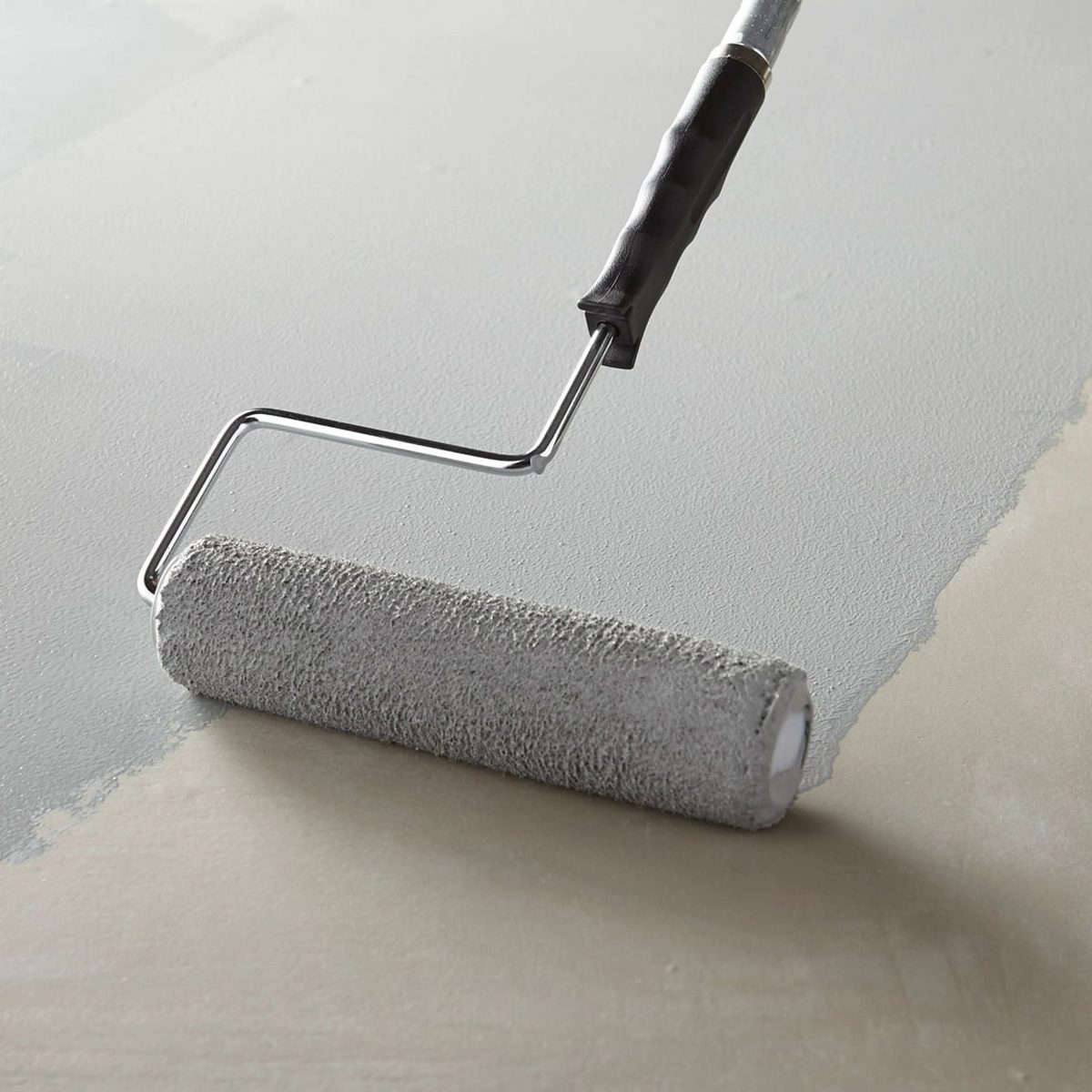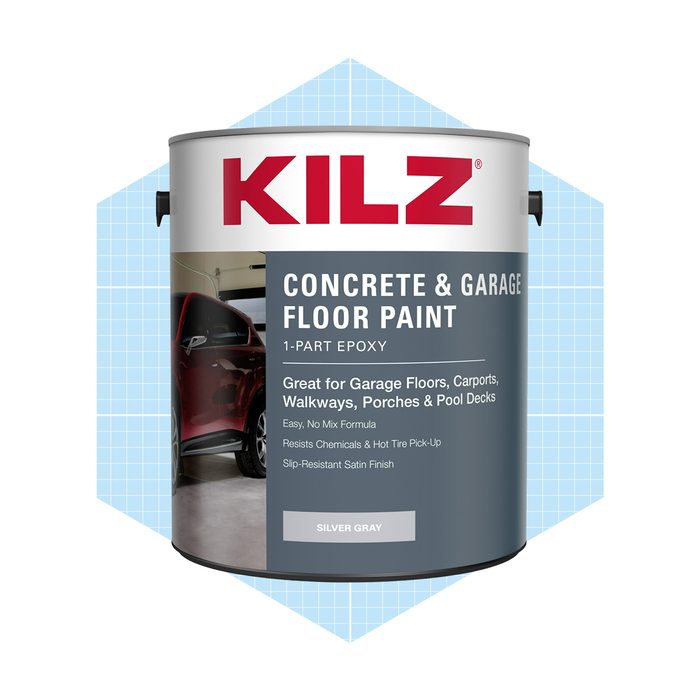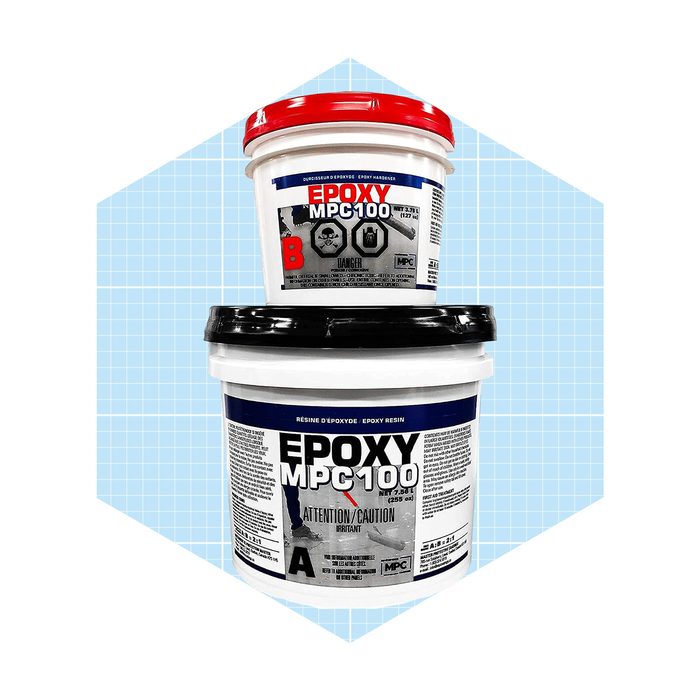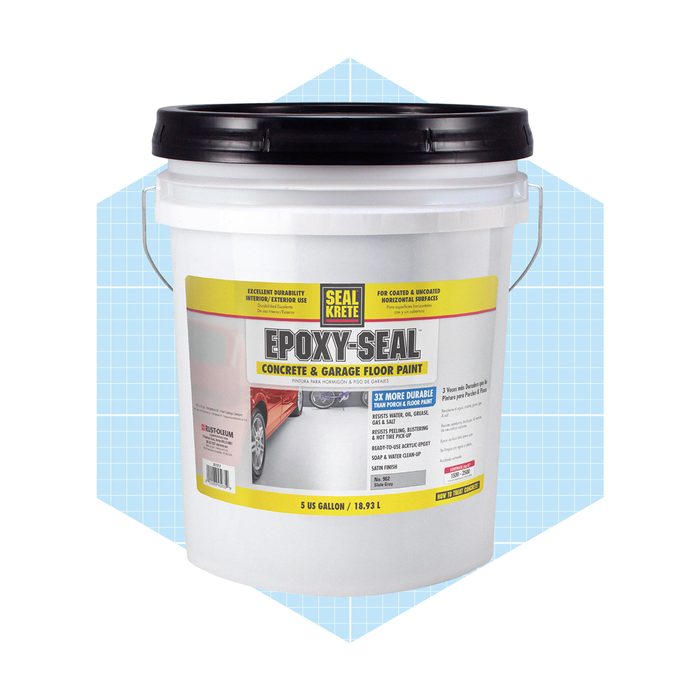Pros:
-
No primer or mixing required
-
Only one coat needed
-
Resistant to scratches, scuffs and hot tires
-
Reasonably price
Cons:
-
Only available in two colors
Craftsman has made a legend of itself with simple, straightforward products that perform well and last seemingly forever. This pro-grade garage epoxy doesn’t need a primer or mixing, and protects floors with just one coat. Craftsman says 1 gallon is enough to cover a 500-square-foot, two-car garage with a light gray, satin finish.
This epoxy for garage floors has a hot tire-resistant coating, and takes about 24 hours to dry. The brands says that it has a mild odor, so it shouldn’t be too bothersome during the painting process.
Pros:
-
Budget-friendly
-
No primer or mixing required
-
Slip-resistant finish
-
Can be used outdoors and indoors
Cons:
-
Some users report visible tire damage over time
Just like the Craftsman, this epoxy from Kilz is a one-part product—no primer, no mixing needed. Plus, the 1-gallon container is available for an affordable price, making this an inexpensive DIY project. In addition to garage floors, this epoxy can be used on walkways, porches, pool decks and more. It comes in silver gray and features a slip-resistant, satin finish.
Pros:
-
Durable and long-lasting
-
Non-slip and resistant to chemicals, dents and damage
-
Self-levels
-
Available in white, gray, black and clear
The MPC-100 epoxy kit for garage floors is on the pricier side, but you get 3 gallons and all indications are that the results last considerably longer. There’s more work involved in applying the MPC 100—not only must the concrete be primed before the sealant, but the manufacturer recommends some significant prep work first. That includes grinding the concrete, filling in any cracks, sanding and leveling the surface and vacuuming the floor. After that, the primer can go on, but allow an extra day for it to cure before applying the finish. Still, buyers rave about the results they get from this 100% industrial-grade epoxy resin.
Pros:
-
Gray, tan and tan gloss options
-
Includes decorative chips, concrete etch and stir stick
-
Resistant to abrasions and chemicals
-
Easy to apply
Cons:
-
Only covers 200 to 250 square feet
If you’re ready to kick the style of your garage floor up a notch or two, the Rust-Oleum ExpoxyShield is a nice way to do it without breaking the bank. It’s available in three different colors: gray, tan and tan gloss. Decorative chips are also included for those who’d like to add a “metal-flake” finish. Keep in mind that there’s added work involved, though. It requires mixing and the brand recommends prep work—cleaning and degreasing, patching and repairing cracks. It’s also worth noting that it takes three days from application before you should drive a car onto it. Nonetheless, buyers say they’re happy with the ease of application and the end result.
Pros:
-
Intended for both indoor and outdoor use
-
Ready to use on coated or uncoated concrete surfaces
-
Long-lasting and resists oil, grease, hot tire pick-up and peeling
-
Comes in a large 5-gallon size
Most of the epoxies for garage floors are meant for indoor use. If you have a carport or driveway you’d like to protect and make easy to clean, the Seal-Krete Epoxy Seal gets our vote for most versatile. It’s an indoor/outdoor epoxy, and can also be used for walkways, pool decks, patios, porches and basements. It comes in a slate gray finish in a 5-gallon container, so you’ll likely have some left over after doing the garage. The manufacturer says you should wait five days before driving a vehicle onto a floor that’s been coated with it.
Pros:
-
Heavy-duty and industrial-grade
-
12 color options plus clear
-
High-gloss finish
-
Can be used on concrete, plywood and bar tops
Beauty is in the eye of the beholder, but if you’re a bit bored with shades of gray for your garage floor, the Colored Epoxies 10019 might be exactly the burst of color your garage needs. This is an epoxy for garage floors that comes not in one or two, but 12 color options (plus clear). Just make sure you won’t need your garage for a while, because it has one of the lengthiest applications, with a recommended time of four days in application alone.
What to Look for When Buying Epoxy for Garage Floors
There’s quite a bit to consider before you make a choice on an epoxy for garage floors. If this is meant to be a weekend project, you don’t want a product with extensive prep and application time. Many epoxies have a recommended temperature range for best application, so make sure that your garage isn’t too hot or too cold during the process. In some parts of the country, that could mean putting off the work until spring or fall.
Carefully consider colors and finishes—this is likely to be a decision you live with for a long time and look at often. And finally, make a realistic assessment of your budget. If your garage ends up needing more than one coat, are you comfortable with doubling the cost? If not, consider one of the more budget-friendly options.
Why You Should Trust Us
I have been an automotive journalist for many, many years. I’ve researched and written about the very best products for your cars and the places you store them. We consulted with James Mayfield, HAZMAT engineer and the CEO and president of Mayfield Environmental Engineering to learn more about what makes epoxy such a great option for your garage floors. Mayfield has run projects involving floor coatings for industrial facilities such as manufacturing plants, waste treatment centers and, of course, garage floors.
How We Found the Best Epoxy for Garage Floors
As an automotive expert and journalist since 1997, I have extensive experience helping you choose the best products for your car and garage. We looked at reviews of dozens of different epoxies for garage floors and evaluated how they stack up in terms of ease of application and durability for every type of need and budget. Only those with exceptionally good consumer reviews made the cut, and those with the highest scores and most relevant benefits and features were chosen as winners.
FAQ
What do professionals use to epoxy garage floors?
Many professionals buy through industrial supply companies, purchasing brands that are not available to the consumer, and in quantities much larger than you’d order for a single garage. That doesn’t necessarily mean you can’t match the quality of the product as a consumer. For example, the MPC-100, Seal-Krete and Colored Epoxies options are all industrial-grade. Get to know how much an epoxy garage floor costs.
How do you prep your floor for epoxy?
“Surface preparation is key with any coating type to ensure optimum adhesion and coverage,” says Mayfield. “As an expert, I always advise customers to thoroughly clean, dry and profile concrete before applying epoxy or other sealants. This small investment pays off in terms of long-term protection and beauty. With the right product and homework, epoxy is tough to beat for reliably shielding garage floors on a budget.”
Is there anything better than epoxy for garage floors?
“Better” is going to depend on your preferences, needs and budget. That said, here are some alternatives to epoxy for garage floors.
What is the downside of an epoxy garage floor?
The hard surface of an epoxy floor can result in a noisier garage. The coating is liable to chip if a sharp tool is dropped on the floor. Installation, curing time and—should you decide to do something else at a later time—removal are all more involved than some other garage flooring solutions.

























